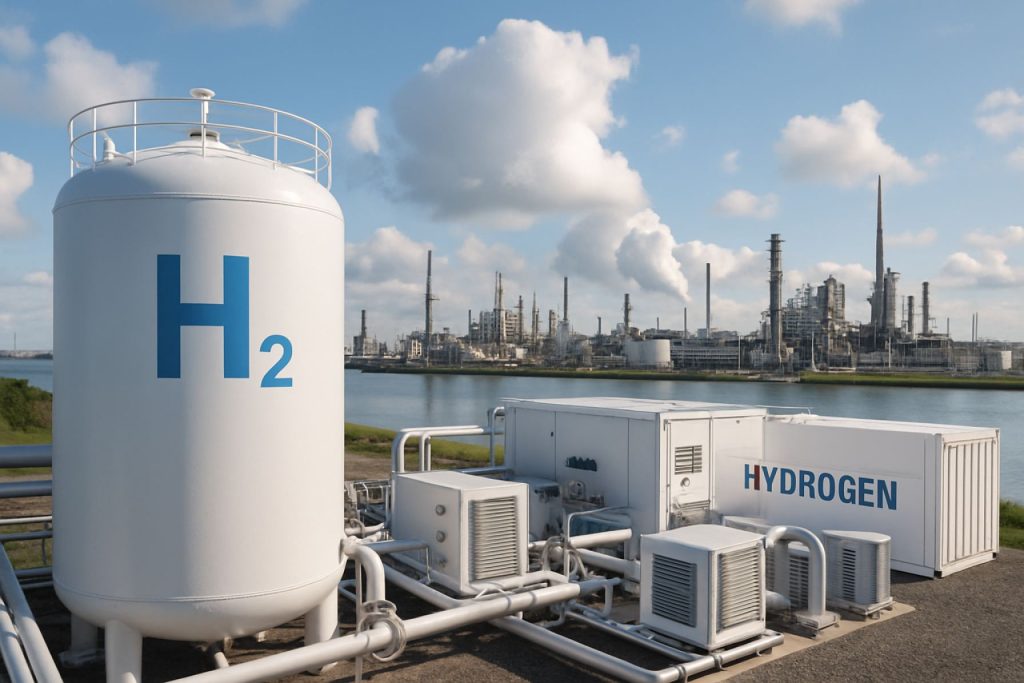
- HyCC’s H2Next project in Rotterdam aims to produce up to 25,000 tons of green hydrogen annually, supporting Northwest Europe’s clean energy transition.
- Situated in the Maasvlakte industrial zone, the facility leverages proximity to the North Sea’s offshore wind farms for renewable energy.
- Green hydrogen will be distributed through new infrastructure, including the national hydrogen network and Delta Rhine Corridor, supplying major industries and refineries.
- The project aligns with decarbonization goals, helping reduce the carbon footprint of Europe’s largest port and enabling compliance with strict environmental regulations.
- Backed by the Port of Rotterdam Authority, H2Next is progressing toward a final investment decision by 2028 and potential hydrogen production by 2030.
The skyline over Rotterdam’s Maasvlakte industrial zone bristles with ambition as HyCC unveils a plan that could reshape the energy landscape. The new H2Next venture, a vast green hydrogen facility, is quietly staking out its place as a potential catalyst for the clean energy transition in Northwest Europe.
Amid a rush of international excitement at the World Hydrogen Summit, HyCC secured coveted ground: a reserved plot at the Netherlands’ first hydrogen conversion park, directly in the path of incoming North Sea winds and close to the planned landfall of colossal offshore wind farms. This bold move signals more than progress—it proclaims commitment to a sustainable industrial tomorrow.
The visual impact is staggering. At full throttle, H2Next’s electrolyzers will churn out an estimated 25,000 tons of clean hydrogen each year. Imagine fleets of trucks, sprawling refinery complexes, and chemical plants—all powered by molecules split from water, not oil. The hydrogen will flow via new arteries like the national hydrogen network and the cross-border Delta Rhine Corridor, offering a lifeline of green energy to industrial giants not just in Rotterdam, but across the power-hungry corridors of Northwest Europe.
This isn’t an exercise in wishful thinking. HyCC’s project, backed by the strategic muscle of the Port of Rotterdam Authority, is rapidly moving from ambitious blueprint toward hard reality. The company is finessing its technical studies, eyeing a final investment decision within the next four years, and targeting a launch of hydrogen production around 2030.
In Rotterdam, where industry burns hot and harbor cranes mingle with wind turbines, the arrival of green hydrogen holds transformative promise. For businesses, it’s a lifeline amid tightening decarbonization mandates. For the climate, it’s a hope that the carbon footprint of Europe’s largest port can finally shrink.
The key takeaway: Europe’s journey to net zero hinges on industrial-scale projects like H2Next. As renewables feed the grid, hydrogen acts as an energy vector and a symbol of what’s next for heavy industry. Rotterdam’s port, a linchpin of global trade, now eyes a second act as one of Europe’s cleanest powerhouses—setting a benchmark for cities worldwide.
For readers seeking to understand the wider implications of hydrogen on the global stage, explore deeper insights at Hydrogen Central, or examine ongoing developments across Europe’s energy infrastructure by visiting Port of Rotterdam Authority and HyCC.
The story unfolding on Maasvlakte proves that the age of green hydrogen is moving from possibility to inevitability—one bold project at a time.
Rotterdam’s Green Hydrogen Revolution: What H2Next Means for Europe’s Clean Energy Future
Introduction
HyCC’s H2Next project in Rotterdam’s Maasvlakte industrial zone isn’t just another green initiative—it’s a cornerstone in Europe’s transition to a zero-carbon economy. While the original announcement highlights green hydrogen milestones, there are critical facts, expert perspectives, and market implications that deserve a deeper dive. Below, discover what sets H2Next apart, the real-world impact, and what you, as a stakeholder or curious observer, can do to prepare for the hydrogen-powered era.
—
Expanded Insights on the H2Next Hydrogen Plant
What Makes Green Hydrogen So Essential?
– Definition: Green hydrogen is produced via electrolysis using renewable electricity (usually wind or solar), unlike grey or blue hydrogen that rely on fossil fuels.
– Role in Decarbonization: According to the International Energy Agency (IEA), green hydrogen could eliminate up to 830 million tonnes of annual CO2 emissions globally if current hydrogen production switched to renewables.[source: IEA Global Hydrogen Review]
– Wide Applications: Beyond heavy industry, hydrogen can decarbonize aviation, shipping, seasonal energy storage, and even home heating in the future.
Features & Technical Highlights of H2Next
– Capacity: Estimated at 25,000 tons/year. For perspective, enough hydrogen to fuel over 150,000 hydrogen-powered trucks annually (at ~150 kg H2 per truck per year).
– Electrolyzer Technology: While the announcement doesn’t specify, HyCC’s track record includes both PEM and alkaline electrolysis—technologies proven for scalability and flexibility.
– Integration with Renewables: The Maasvlakte site’s proximity to planned offshore wind farms ensures direct, renewable energy input, reducing transmission losses and cost.
– Distribution Network: Hydrogen will be moved via two major corridors—the Dutch national hydrogen backbone and the Delta Rhine Corridor—boosting cross-border (Netherlands-Germany) clean fuel trade.
Market Forecast & Industry Trends
– Global Market Growth: The green hydrogen market is projected to grow at a CAGR of over 40%, reaching $89.2 billion by 2030 (Source: BloombergNEF).
– Northwest Europe’s Leadership: Rotterdam and the Netherlands are at the frontline with robust government incentives, port infrastructure, and strategic partnerships.
Real-World Use Cases
– Refinery Decarbonization: Royal Dutch Shell and BP have signaled interest in green hydrogen to decarbonize their petrochemical processes.
– Transport: Dutch rail operator NS and leading trucking companies plan hydrogen pilots using Rotterdam as a fuel hub.
– Fertilizer Production: Green hydrogen can replace “grey” hydrogen in ammonia plants, a key input for fertilizers.
—
Review: Pros, Cons & Limitations
Pros
– Massive Emissions Reduction: Displaces fossil hydrogen and reduces maritime/industrial CO2 emissions.
– Energy Security: Diversifies Europe’s fuel sources, lessening dependence on Russian natural gas.
– Global Leadership: Positions Rotterdam as a green export gateway; potential job creation and new business models.
Cons & Controversies
– Economic Viability: Green hydrogen costs 2–5 times more than grey hydrogen (as of 2024). Price parity may depend on carbon taxes and further technological improvements.
– Water Use: Electrolysis needs significant water input—potential issue for drought-prone regions.
– Grid Impact: Large-scale hydrogen production requires reliable, surplus renewable energy; risks of grid congestion or supply gaps remain.
—
Security & Sustainability Considerations
– Safety: Hydrogen is flammable; safety in pipeline distribution and storage is critical. Rotterdam’s advanced port security protocols will be essential.
– Long-term Sustainability: When powered 100% by renewables, hydrogen offers nearly closed-loop carbon cycles—key for true net-zero targets.
—
Step-by-Step: How Does Green Hydrogen Production Work?
1. Electricity Generation: Offshore wind turbines produce renewable electricity.
2. Electrolysis: Electricity powers electrolyzers to split water into hydrogen and oxygen.
3. Storage & Compression: Hydrogen is stored under high pressure or liquefied for distribution.
4. Transport: Pipeline/networks move hydrogen to industrial and transport users.
—
Expert Opinions & Predictions
– Shell & BP R&D Leads: Both have described Rotterdam as a “natural epicenter” for green hydrogen ramp-up due to location, policy, and infrastructure (FT Energy Summit 2023).
– EurActiv and IEA: Experts warn of a “hydrogen bottleneck” without streamlined permitting and faster grid upgrades, but commend the Dutch for proactive planning.
—
Actionable Recommendations & Quick Tips
1. For Businesses: Begin R&D partnerships and pilot projects via Rotterdam’s industrial clusters to secure early hydrogen access and carbon reduction credits.
2. For Investors: Monitor HyCC and Port of Rotterdam news for updates on the investment decision—early movers could benefit from EU hydrogen incentives.
3. For Policymakers: Reinforce funding for electrolyzer R&D, grid modernization, and cross-border hydrogen highway initiatives.
4. For Consumers & Students: Explore hydrogen basics at Hydrogen Central, and track real-world progress via the Port of Rotterdam Authority and HyCC.
—
Most Pressing Questions Answered
– When will H2Next produce hydrogen? Target launch is around 2030.
– Will this make hydrogen cheap? Prices will decrease as scale and renewable deployment rise, but initial costs remain high.
– Is the Netherlands the leader? It’s among the leaders, but Germany, Denmark, and Norway also invest heavily in green hydrogen corridors.
– Environmental footprint? Minimal if supplied by renewables, but water use and electrolysis efficiency should be monitored.
—
Conclusion: Rotterdam’s H2Next Sets a Global Benchmark
HyCC’s H2Next isn’t just a local project—it’s a bellwether for Europe’s clean hydrogen ambitions. Success here could set off a domino effect across the continent, making green hydrogen an everyday part of energy, industry, and transport. Early engagement—whether by business, government, or individuals—ensures a cleaner, more resilient energy future for all.



